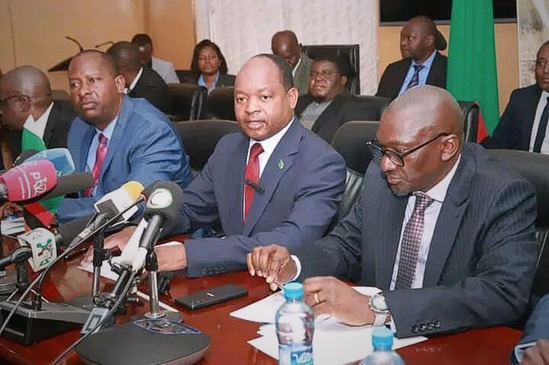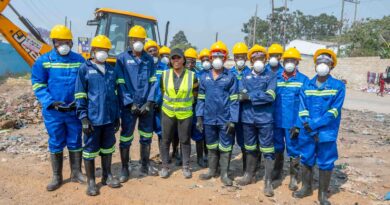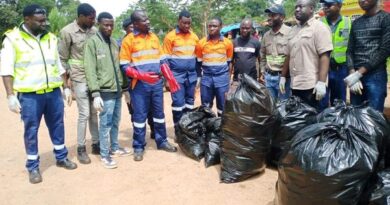Zambia and U.S. at Odds Over Risks of Contained Mine Spill
The Zambian government has moved to allay public and international concerns following the U.S. Embassy’s recent withdrawal of personnel from parts of the Copperbelt Province over health risks stemming from a toxic mine spill that occurred earlier this year.
Speaking at a joint press briefing in Lusaka on Thursday, Chief Government Spokesperson Cornelius Mweetwa assured the nation that the environmental disaster triggered by a tailings dam failure at Sino Metals Leach Zambia Limited in Chambishi on February 18 has been fully contained and poses no current risk to human, animal, or plant life.
“There is absolutely no need to press the panic button,” Mweetwa stated. “The immediate danger has been averted. The situation is under control.”
The press briefing followed the U.S. Embassy’s August 5 health alert, which cited new data indicating elevated levels of arsenic, cyanide, uranium, and other heavy metals in areas downstream from the spill site. The embassy advised U.S. citizens to avoid municipal water in Chambishi, Kitwe, and surrounding areas and withdrew its staff from the affected zones.
While Mweetwa refrained from directly criticizing the U.S. decision, his comments carried a tone of frustration.
“This incident happened over six months ago,” he said. “Let us not undermine the work of our institutions.”
According to the government, approximately 50,000 cubic meters of acidic tailings were released into the Chambishi Stream and its tributaries, eventually reaching the Kafue River. In response:
- The Zambia Environmental Management Agency (ZEMA) ordered the immediate suspension of Sino Metals’ operations.
- Lime dosing was carried out to neutralize acidity in the affected waterways.
- By early March, pH levels had reportedly normalized to above 7, within acceptable international standards.
- Over 200 environmental samples were collected, with 37 already analyzed and the rest undergoing testing at Alfred H. Knight, an independent laboratory in Kitwe.
While initial samples showed elevated levels of copper, cobalt, manganese, and other metals, the government says “appropriate remedial actions were taken immediately,” and no deaths or confirmed cases of heavy metal poisoning have been reported.
Mweetwa praised Nkana Water Supply and Sanitation Company for its swift action in shutting down two treatment plants on February 20 after detecting abnormal pH levels. The plants resumed operations only after confirming water quality restoration. Emergency water deliveries were made to affected communities during the shutdown.
The Ministry of Health continues to monitor for any long-term health effects. Three suspected water-related illnesses were reported in Ngabwe but the patients fully recovered.
In terms of accountability:
- Sino Metals was fined more than K1.5 million for the spill, which has been paid.
- A compliance order with 12 corrective actions was issued to the company.
- Compensation has begun for affected families whose crops and soils were damaged.
- The failed tailings dam is currently being decommissioned.
Furthermore, the government has mandated that all mining and processing companies must neutralize acidic tailings prior to disposal. Existing tailings dams have until December 2025 to comply with the new regulation.
An Environmental Impact Assessment (EIA), which Sino Metals failed to initiate, will now be carried out under government oversight, with the costs charged to the company under the polluter pays principle.
The timing of the U.S. health alert has drawn attention, coming just days after the United States introduced a controversial $15,000 refundable bond requirement for tourist and business visa applicants from Zambia and Malawi, a policy that has sparked public backlash. Though Washington has not linked the two developments, the coincidence has fueled speculation.
Kitwe, one of Zambia’s largest cities and home to over 500,000 people, lies downstream of the spill and is central to the nation’s mining sector. The Copperbelt region accounts for over 70% of Zambia’s export earnings.
Environmental groups have long criticized what they see as weak regulatory enforcement and ageing mining infrastructure in the region. However, the Zambian government maintains that this time, the response was both rapid and comprehensive.
Mweetwa emphasized that testing and monitoring will continue, and results will be shared transparently.
“Government remains firm in its resolve to protect the environment, safeguard public health, and promote sustainable development for current and future generations,” he said.
The final laboratory results and the upcoming EIA are expected to provide further insight into the full extent of the environmental damage and guide the long-term recovery process.



